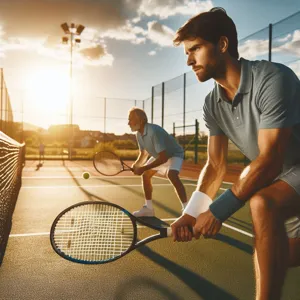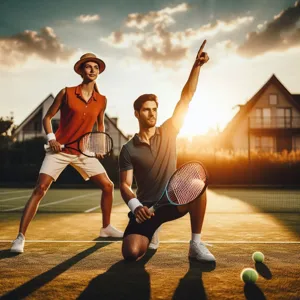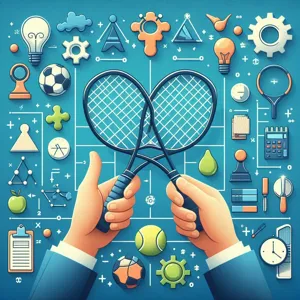Golf, often hailed as a game of patience and precision, is even more enjoyable when shared with a good friend or a like-minded partner.
Whether you’re a seasoned pro or just starting to explore the lush greens, having a reliable golf partner can enhance your experience on the course, provide motivation, and make those long rounds of 18 holes feel like a breeze. But how do you find that perfect golfing companion who matches your skill level, shares your enthusiasm, and complements your playing style? This ultimate guide, “Tee Time Together,” is here to help you navigate the fairways of friendship and partnership in golf. From exploring local clubs and online communities to leveraging social media and tapping into your existing network, we’ll equip you with the best strategies to find the ideal golf partner who will not only elevate your game but also make every swing more enjoyable. So grab your clubs and get ready to discover the joy of golfing together!
1. The Importance of Having a Golf Partner

When it comes to enjoying a day on the greens, having a golf partner can make all the difference. Beyond the obvious camaraderie, playing with a partner elevates the entire experience, transforming a solitary round into a social occasion filled with friendly competition and shared laughter. A golf partner provides motivation when your swing is off, encouragement when your confidence wavers, and a sounding board for those post-round discussions about strategy and technique.
Moreover, having someone to share the fairways with fosters accountability; you’re less likely to skip a round when you know someone is counting on you. This partnership also enhances the learning curve—whether you’re a seasoned player or a novice, exchanging tips and techniques can help both partners improve their game.
Additionally, the shared experience of navigating the course together strengthens your bond, creating memories that extend beyond just the game. From celebrating each other’s birdies to strategizing over a missed putt, these moments are what make golf more than just a sport; they turn it into an opportunity for connection and friendship.
In essence, a golf partner isn’t just an extra set of clubs on the course; they are a vital component of your golfing journey. Whether you’re seeking to improve your skills, enjoy the great outdoors, or simply unwind from a hectic week, having a golf partner by your side enriches every tee time, making each round a celebration of both the game and the companionship it fosters.
2. Where to Start Your Search for a Golf Partner
Finding the right golf partner can enhance your game and make those long hours on the course even more enjoyable. But where do you begin your search? There are several avenues you can explore, each offering unique opportunities to connect with fellow golf enthusiasts.
**1. Local Golf Clubs and Courses:** One of the most straightforward options is to check out your local golf clubs and courses. Many facilities have bulletin boards or online communities where members can post about looking for playing partners. Additionally, consider joining club tournaments or social events where you can meet like-minded golfers in a relaxed environment. This not only helps you find a partner but also allows you to network within the golfing community.
**2. Online Golf Communities and Forums:** The internet is a treasure trove of resources for golfers seeking partners. Websites and forums, such as GolfWRX, Reddit’s r/golf, or dedicated golf apps, enable you to connect with players in your area. You can post your profile, share your skill level, and specify your preferred playing times. Engaging in discussions on these platforms can also lead to finding potential partners who share your passion for the sport.
**3. Social Media Groups:** Platforms like Facebook and Instagram have various groups dedicated to golf. Search for local golf groups in your area where members often look for partners or organize meet-ups. Engaging with these groups through comments and posts can help you forge connections that might lead to a new golfing buddy.
**4. Golf Leagues:** Many regions host amateur golf leagues, which are perfect for meeting other golfers. These leagues often accommodate different skill levels, allowing you to find a partner who matches your ability. Playing in a league not only offers a chance to play regularly but also fosters camaraderie among players.
**5. Friends and Family:** Don’t overlook the people in your life! Sometimes, the best golf partners are those who are already in your circle. Ask friends, family members, or colleagues if they play or would be interested in learning. If you find someone new to the sport, this can be a rewarding experience as you both improve your skills together.
By exploring these various avenues, you’ll increase your chances of finding the perfect golf partner who can motivate you to play more often, improve your game, and enjoy the beautiful camaraderie that golf has to offer. Whether it’s a seasoned pro or a fellow newbie, the right partner can make all the difference in your golfing journey.
3. Online Platforms and Apps for Finding Golf Partners

In today’s digital age, finding a golf partner is as easy as tapping a few buttons on your smartphone or laptop. Various online platforms and apps have emerged, designed specifically to connect golfers of all skill levels. Whether you’re a seasoned pro looking for a competitive edge or a beginner eager to learn, these tools can help you find the perfect match.
One popular platform is **GolfMatch**, which allows users to create profiles, indicating their skill levels, preferred courses, and availability. The app’s intuitive interface makes it simple to search for golf partners nearby, ensuring you can hit the greens with someone who shares your passion for the game. You can also check out user reviews and ratings to find a partner who fits your golfing style.
Another excellent option is **Meetup**, a social networking site that enables users to join groups based on shared interests, including golf. You can easily find local golf clubs or casual meetups where you can connect with fellow enthusiasts. These groups often organize regular games and events, providing a fantastic way to build relationships both on and off the course.
For those who prefer a more targeted approach, consider downloading **18Birdies**. This app not only helps you track your scores and stats but also features a ‘Find a Partner’ tool. By inputting your location and preferred playing conditions, you can connect with golfers who match your criteria, making it easier to set up tee times.
Don’t overlook the power of social media platforms like Facebook and Instagram, where specific golf groups and pages can facilitate connections. Many communities are dedicated to the sport, offering forums for players to post their availability or seek partners for upcoming rounds. Engaging with these online communities can lead to lasting friendships and regular golfing buddies.
With these platforms and apps at your fingertips, finding a golf partner has never been easier. Embrace the technology available to you, and soon you’ll be enjoying unforgettable rounds on the course, complete with the camaraderie and competition that make golf so enjoyable.
4. Local Golf Clubs and Communities: Connecting with Fellow Golfers
Local golf clubs and communities serve as the heartbeat of golfing culture, offering a welcoming space where enthusiasts of all skill levels can connect, share experiences, and build lasting relationships on the green. Whether you’re a seasoned player or just picking up a club for the first time, these venues provide ample opportunities to meet potential golf partners who share your passion for the sport.
Joining a local golf club can be one of the best decisions you make in your quest for a golfing companion. Most clubs offer membership options, which often include access to exclusive tee times, social events, and tournaments. These gatherings are perfect for mingling with fellow golfers, allowing you to strike up conversations and find those who might be interested in playing together. Many clubs also have bulletin boards or online forums where members can post requests for partners, making it easier to connect with others seeking a game.
In addition to clubs, consider seeking out community golf leagues or organizations. These groups often host regular outings, friendly competitions, and casual meetups, providing an excellent platform to meet new people. Participating in these events not only sharpens your skills but also exposes you to a diverse range of players, each with their own unique style and approach to the game.
Don’t overlook the power of social media and online platforms dedicated to golfers. Websites and apps like Meetup, GolfNow, or even local Facebook groups can help you find golfing buddies in your area. These platforms allow you to specify your skill level, preferred playing times, and even the type of courses you enjoy, making it easier to find the perfect match.
Ultimately, engaging with local golf clubs and communities opens the door to a wealth of connections and friendships. Whether you’re looking for someone to share tips and tricks with or simply want a partner to share a round of 18 holes, these avenues are sure to enhance your golfing experience and keep you motivated to hit the course. So, grab your clubs, step out of your comfort zone, and get ready to meet some fantastic fellow golfers!
5. Social Media: Leveraging Networks to Find Your Ideal Partner

In today’s digital age, social media platforms have transformed the way we connect, making it easier than ever to find a golf partner who matches your interests and skill level. Leveraging these networks not only broadens your search but also allows you to engage with a community of fellow golf enthusiasts.
Start by joining golf-related groups on platforms like Facebook, where you can find local players who share your passion for the game. Post a message expressing your desire to find a partner for weekend rounds or casual driving range sessions; you might be surprised by how many fellow golfers are eager to join you. Remember to include details about your skill level, preferred courses, and availability to attract the right fit.
Instagram can also be a valuable tool for connecting with potential partners. Follow local golf courses, clubs, and golf influencers who often share insights and events in your area. Don’t hesitate to engage with their content—comment on their posts, share your own golfing experiences, and use relevant hashtags like #GolfBuddy or #GolfTogether to increase your visibility.
Alternatively, consider using specialized platforms and apps designed for finding golf partners. These apps allow you to create a profile, specify your location, and even filter potential partners based on skill level and availability. This targeted approach makes it easier to find someone who suits your game.
Lastly, don’t underestimate the power of Twitter and LinkedIn. Post a tweet or a professional connection inquiry detailing your search for a golf partner. You might just connect with someone from your existing network who shares your interest in the sport.
By effectively utilizing social media and online platforms, you can expand your golfing circle, meet new friends, and enjoy countless rounds of golf together. So, grab your clubs, engage with the community, and prepare for some memorable tee times ahead!
6. Tips for Approaching Potential Golf Partners
Finding the perfect golf partner can enhance your experience on the course, making each round more enjoyable and productive. However, approaching potential partners can sometimes feel daunting, especially if you’re unsure of how to break the ice. Here are some tips to help you strike up a conversation and find that ideal golfing buddy.
**1. Start with Common Ground:** If you’re at a local golf course or a driving range, use your surroundings as a conversation starter. Compliment someone’s swing or ask for tips on improving your own. This not only opens up dialogue but also establishes a shared interest right off the bat.
**2. Attend Group Events:** Many golf clubs host social events, tournaments, or charity outings. Participating in these gatherings allows you to meet fellow golfers in a relaxed environment. Don’t hesitate to introduce yourself and express your desire to find a regular playing partner.
**3. Utilize Social Media and Apps:** In today’s digital age, there are numerous platforms dedicated to connecting golfers. Join local golf groups on social media or download apps designed for finding golf partners. Be open about your skill level and what you’re looking for in a partner—whether it’s a casual round or competitive play.
**4. Be Friendly and Approachable:** A warm smile and a friendly demeanor can go a long way. When you’re on the course, don’t hesitate to chat with those in your vicinity. You never know who might be looking for someone to play with.
**5. Ask for Recommendations:** If you have friends or acquaintances who play golf, ask them if they know anyone looking for a partner. Word of mouth can be an effective way to connect with like-minded individuals who share your passion for the sport.
**6. Communicate Your Goals:** When you do meet someone you’d like to play with, be honest about your intentions. Whether you’re looking to improve your game, have fun, or compete, clear communication can help set the right expectations for both of you.
Approaching potential golf partners doesn’t have to be intimidating. With a little confidence and the right strategies, you can build meaningful connections on the course and enjoy countless rounds of golf together. So grab your clubs, step out of your comfort zone, and start forging those valuable relationships that will enhance your golfing journey!
7. Setting Expectations: What to Look for in a Golf Partner

Finding the perfect golf partner can significantly enhance your experience on the course, making it both enjoyable and productive. Setting clear expectations is crucial in this pursuit, as it allows both you and your potential partner to align your goals and style of play.
First and foremost, consider the skill level you desire in a partner. Are you looking for someone who can match your current ability, or perhaps someone a bit more advanced to help you elevate your game? If you’re a beginner, teaming up with a more experienced player can provide valuable insights and mentorship. Conversely, if you’re an advanced golfer, you might seek a partner who can challenge you and push your boundaries, fostering a competitive yet fun atmosphere.
Next, think about the pace of play that suits you best. Golf can be a leisurely game, but some players prefer a quicker round. Discussing your expectations regarding the pace at which you like to play can help prevent frustration later on. Additionally, consider the type of communication you prefer: do you enjoy light banter and casual conversation during rounds, or do you prefer a more focused, quiet environment?
Another vital expectation to set is regarding commitment. Determine how often you both intend to play and whether you’re looking for a casual relationship or a more dedicated partnership. This will help ensure that both parties are on the same page, preventing misunderstandings about scheduling and availability.
Finally, it’s essential to discuss the overall attitude and sportsmanship you expect from your partner. Golf is as much about etiquette and camaraderie as it is about competition. A positive attitude, respect for the game, and sportsmanship will contribute greatly to a rewarding golfing experience.
By taking the time to set clear expectations, you’ll increase your chances of finding a golf partner who not only complements your style of play but also enhances your enjoyment of the game. After all, the right partner can turn an ordinary day on the course into an extraordinary one, filled with laughter, learning, and lasting memories.
8. The Role of Skill Levels in Choosing a Partner
When it comes to finding the perfect golf partner, skill levels play a crucial role in ensuring an enjoyable and productive round on the course. Golf is as much about camaraderie as it is a competition, and pairing up with someone whose skill level complements your own can enhance both your experience and your game.
For beginners, playing with a more experienced golfer can be incredibly beneficial. Not only can they offer tips and tricks to improve your swing or putting technique, but they can also provide valuable insights into course management and etiquette. This mentorship can help you build confidence and develop essential skills in a supportive environment. However, be mindful of choosing a partner who is patient and understanding, as frustration can arise if the skill gap is too wide.
Conversely, seasoned golfers may enjoy the challenge of playing with peers who share a similar skill set. This not only fosters a competitive spirit but also encourages friendly banter and camaraderie. Playing alongside fellow skilled golfers can push you to elevate your game, as you strive to match their shots and strategize together.
Additionally, consider your goals for the game when selecting a partner. If your primary objective is to relax and enjoy the day outdoors, teaming up with a casual player might be your best bet. On the other hand, if you’re looking to improve your performance or prepare for an upcoming tournament, aligning yourself with a more competitive golfer can provide the motivation and focus you need.
Ultimately, the ideal golf partner is one who not only matches your skill level but also shares your enthusiasm for the game. Whether you’re a novice or a seasoned pro, finding the right balance ensures that every round is a rewarding experience, filled with laughter, learning, and the pursuit of that elusive hole-in-one.
9. Creating a Golf Buddy Agreement: Setting Ground Rules
Creating a Golf Buddy Agreement is a vital step toward ensuring a smooth and enjoyable experience on the course. Just like any partnership, having clear expectations can make all the difference in your time spent together. Start by discussing your individual goals for the game—whether it’s improving your swing, enjoying a leisurely round, or participating in friendly competition. Being on the same page will help shape the nature of your golfing outings.
Next, set boundaries for the frequency and duration of your rounds. Decide on how often you want to play, whether that’s weekly, bi-weekly, or monthly, and stick to a schedule that accommodates both partners. This not only helps with planning but also fosters a sense of commitment to one another.
Consider discussing the logistics of your golfing outings, including preferred courses, tee times, and transportation arrangements. Do you both prefer early morning rounds to beat the heat, or are weekend afternoons more your style? Establishing these preferences will minimize any last-minute confusion.
Another essential aspect is establishing a code of conduct on the course. Agree on aspects such as pace of play, etiquette, and handling disagreements. Whether it’s honoring each other’s space during swings or discussing what to do in case of a missed shot, having a mutual understanding will enhance your experience and create a more harmonious environment.
Finally, don’t forget to include a fun clause! Golf is, after all, a game meant to be enjoyed. Incorporate light-hearted elements like friendly wagers, challenges, or even post-round celebrations to keep the spirit of camaraderie alive. By creating a Golf Buddy Agreement with clear ground rules, you can ensure that your time on the greens is not just productive but also enjoyable, paving the way for a lasting golf partnership.
10. Planning Your First Round Together: What to Consider
Planning your first round of golf together is an exciting step in solidifying your new partnership on the course. However, it’s essential to consider a few key factors to ensure that both you and your new golf buddy have an enjoyable experience.
**Choosing the Right Course**: Begin by selecting a golf course that matches both your skill levels. If one of you is a seasoned player while the other is a beginner, opting for a more forgiving course can help ease any pressure. Many public courses offer various tees, making it easier to find a suitable challenge for both players. Additionally, consider the course layout: a scenic, less crowded course can enhance the experience and allow for more relaxed play and conversation.
**Scheduling the Round**: Timing is crucial when planning your first tee time. Choose a day and time that works for both of you, ideally when the course is less crowded, such as early morning or late afternoon. This will not only help you avoid long waits but also allow for a more leisurely pace, giving you time to chat and get to know each other better.
**Setting Expectations**: Before you hit the links, have a candid conversation about your expectations for the round. Discuss pace of play, whether you prefer to take it seriously or keep it lighthearted, and any specific goals you might have, such as practicing particular skills or simply enjoying the day. This open communication will help set a positive tone and ensure that you’re both on the same page.
**What to Bring**: Make sure to pack all the essentials—clubs, balls, tees, and appropriate attire. Don’t forget sunscreen and plenty of water, especially if you’re playing on a hot day. It can also be a good idea to bring a few snacks to keep your energy up and to share a few laughs along the way.
**Post-Round Plans**: Consider planning a post-round meal or drink to unwind and recap your day. Sharing a meal is a fantastic way to bond, reflect on your game, and discuss future rounds. Whether it’s a casual burger at the clubhouse or a visit to a nearby restaurant, this simple gesture can deepen your connection and pave the way for more rounds together.
By taking these factors into account, you’ll set the stage for a memorable first round filled with laughter, camaraderie, and the beginnings of a fantastic golfing partnership. Remember, it’s not just about the score but the shared experience that truly counts in the game of golf.
11. Keeping the Partnership Fun and Engaging
When it comes to golf, the journey is just as important as the destination. Keeping your partnership fun and engaging is essential for fostering a lasting bond on and off the course. After all, the game is as much about laughter and camaraderie as it is about perfecting your swing or sinking that elusive putt.
Start by mixing up your routine. While it’s great to have your go-to courses, exploring new greens can add a sense of adventure and excitement. Discovering hidden gems in nearby towns or playing at different times of day can create memorable experiences that deepen your connection. Consider planning themed outings, like a “retro golf day” where you and your partner dress in vintage attire, or a “challenge day” where you set fun, personal goals and compete against each other in a light-hearted manner.
Moreover, don’t underestimate the power of a little friendly competition. Create mini-tournaments or informal challenges to spice things up. Whether it’s a longest drive contest or a putting accuracy challenge, these little competitions can inject some playful rivalry into your rounds, making each outing more exhilarating.
Another way to keep the partnership engaging is to share your golfing goals and progress. Support each other in improving your skills, whether through practice sessions or by exchanging tips and techniques. Celebrate each other’s milestones, no matter how small—they can be the highlights of your golfing journey together.
Lastly, make sure to maintain open communication. Ask your partner for feedback on your game, share your own thoughts, and discuss what you both enjoy and want from your time on the course. This transparency can lead to more fulfilling rounds and ensure that each outing is something you both look forward to.
By prioritizing fun and engagement, you’ll not only enhance your golfing experience but also cultivate a strong partnership that extends beyond the fairways. So grab your clubs, share some laughs, and enjoy every moment spent together on the greens!
12. Overcoming Challenges in Finding a Golf Partner
Finding the perfect golf partner can sometimes feel like navigating a tricky course filled with obstacles. Whether it’s conflicting schedules, varying skill levels, or simply the fear of putting yourself out there, the challenges can seem daunting. However, overcoming these hurdles is not only possible but can also lead to rewarding experiences on and off the green.
One common challenge is aligning schedules. With our busy lives, it can be tough to find someone who is available at the same time. To tackle this, consider joining local golf clubs or groups that have regular meet-ups. These organizations often have a structured schedule that allows for more consistent playdates, making it easier to find someone whose timing matches yours. Additionally, leveraging social media platforms and golf apps can help you connect with others who share your availability.
Skill level can also be a significant factor. If you’re an advanced player, you might be hesitant to partner with someone who is just starting out, and vice versa. However, embracing different skill levels can enhance your game. Consider being open to playing with newcomers; not only will you help them improve, but you may also find that their enthusiasm reignites your own love for the game. Alternatively, look for local leagues or friendly tournaments that cater to various skill levels, allowing you to find a partner who matches your game.
Lastly, the fear of rejection can hinder your efforts. It’s natural to worry about how someone might perceive your invitation to play. Remember, golf is a community sport, and many players are eager to meet new people. Approach potential partners with confidence and a friendly demeanor. Whether it’s a casual chat on the driving range or a request sent through a golf app, you’ll often find that fellow golfers are more than willing to share their tee time with you.
By addressing these challenges head-on, you can create connections that not only enhance your golf game but also enrich your social life. So grab your clubs, put on a smile, and get ready to tee off with a new partner!
13. Expanding Your Golf Network: Group Play and Events
Expanding your golf network through group play and events is one of the most effective ways to find a reliable and enjoyable golf partner. While solo rounds can be peaceful and reflective, joining group activities opens the door to new friendships, shared experiences, and a wealth of golfing knowledge. Whether you’re hitting the links with a larger group or participating in organized tournaments, these opportunities allow you to connect with fellow golf enthusiasts who share your passion for the game.
Consider joining local golf clubs or community leagues that host regular group outings. These environments are often welcoming and encourage players of all skill levels to participate. Many clubs organize weekly or monthly scrambles, where teams are formed, and players rotate through holes, making it easy to meet new people. Not only will you enhance your game by playing alongside varied skill sets, but you’ll also get the chance to engage in friendly banter and camaraderie.
Furthermore, look for golf events such as charity tournaments, corporate outings, or social gatherings. These events are typically designed to foster networking and often attract a diverse group of players. Participating in these activities not only allows you to showcase your skills but also provides the perfect platform to bond over shared interests, exchange tips, and perhaps even find that perfect golf partner you’ve been seeking.
Don’t forget the power of social media and online platforms dedicated to golf enthusiasts. Websites and apps that connect players can facilitate group bookings and events in your local area. Engaging with these communities can help you find others looking for a golf buddy or organize your own outings, thus expanding your network further.
As you dive into group play and events, remember that the goal is not just to improve your game but also to enjoy the experience. Stay open to meeting new people, embrace the spirit of camaraderie, and you’ll soon find yourself surrounded by fellow golfers who can elevate both your game and your enjoyment of the sport.
14. Testimonials: Stories from Successful Golf Partnerships
When it comes to finding the perfect golf partner, there’s no better way to inspire confidence than through the experiences of others who have successfully formed their own partnerships. Testimonials serve as powerful narratives that highlight the joy, camaraderie, and growth that can come from sharing the fairways with like-minded individuals.
Consider the story of Sarah and Mike, who met through a local golf meetup. Both were relatively new to the sport but shared a passion for improvement and a love for the game. Over the course of a summer, they not only honed their skills together but also forged a friendship that extended beyond the golf course. “Golf became our weekly escape from the hustle and bustle of life,” Sarah recalls. “We challenged each other, celebrated each other’s victories, and even created our own mini-tournaments to keep things exciting!”
Then there’s Tom, a seasoned golfer, who found an equally passionate partner in Emily. Their partnership blossomed from casual rounds together to participating in local tournaments. “Having Emily by my side not only made my game better, but it also made the entire experience more enjoyable,” Tom shares. “We’ve built a community of friends through our mutual love of golf, and I can’t imagine my weekends without our rounds together.”
These testimonials showcase how successful golf partnerships can transform an individual’s experience on the course. They highlight not just the benefits of skill development and competition, but also the friendships and sense of community that can arise from shared tee times. Whether you’re a beginner or a seasoned player, reading these stories may just motivate you to seek out your own golf partner and embark on your own journey of shared passion and growth. So, grab your clubs, embrace the stories of others, and get ready to write your own chapter in the world of golf partnerships!
15. Conclusion: Enjoying the Game Together
As we wrap up this comprehensive guide on finding the perfect golf partner, it’s essential to remember that the essence of the game lies not just in the scorecard but in the shared experiences on the course. Golf is a beautiful blend of challenge and camaraderie; it’s about the laughter shared after a well-executed shot or the friendly banter that ensues following a missed putt.
Whether you’re a seasoned player or a newcomer to the sport, having a partner by your side enriches the game, turning each round into an opportunity for connection, learning, and fun. Together, you can explore new courses, celebrate personal milestones, and inspire each other to improve. The friendships forged on the fairway often extend beyond the greens, creating lasting bonds grounded in a mutual love for the sport.
So, as you set out on your journey to find a golf partner, keep in mind that the right person can transform your golfing experience. Embrace the process, be open to meeting new people, and don’t hesitate to reach out to your network. The thrill of competition, the joy of shared victories, and the solace of quiet moments on the course are all waiting for you. Get out there, swing those clubs, and most importantly, enjoy the game together! After all, it’s not just about the perfect drive or the best score; it’s about the memories you create along the way. Happy golfing!
As we wrap up our ultimate guide to finding the perfect golf partner, we hope you’re feeling inspired and equipped to hit the greens with someone who shares your passion for the game. Building a strong golfing partnership can enhance not only your skills but also your enjoyment of the sport. Whether you choose to connect through local clubs, online platforms, or simply by reaching out to friends, the key is to find someone who complements your style and enthusiasm. So grab your clubs, invite that potential partner, and get ready to share laughter, challenges, and unforgettable moments on the course. Here’s to many successful rounds of golf together—tee time awaits!








